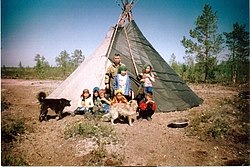| Numto | |
|---|---|
| Нумто | |
 View of the wetland area surrounding lake Numto | |
Location in the Khanty-Mansi Autonomous Okrug, Russia | |
 Numto lake ONC map section. | |
| Location | Beloyarsky District |
| Coordinates | 63°31′N 71°27′E / 63.517°N 71.450°E |
| Lake type | Thaw lake |
| Primary outflows | Nadym |
| Basin countries | Russia |
| Max. length | 12.5 kilometres (7.8 mi) |
| Max. width | 7.5 kilometres (4.7 mi) |
| Surface area | 62 square kilometres (24 sq mi) |
| Islands | One |
| Settlements | Numto |
Numto (Russian: Нумто) is a freshwater lake in Khanty-Mansi Autonomous Okrug, Russia.[1][2] The village of Numto, part of the Kazym rural settlement, is located at the southwestern of the lake by its shore. Historically it was the place where the Kazym rebellion flared up in the early 1930s.[3]
Oil and gas exploration controversy
[edit]Numto is a traditional sacred site for the local Khanty people.[4] The lake is part of an integrated 597,189.5 hectares (1,475,687 acres) protected area which was established in 1997 in Beloyarsky District[5] and which is complemented by the Numto Natural Park in adjacent Nadymsky District of Yamalo-Nenets Autonomous Okrug to the north.[6] The area, however is under threat from oil and gas drilling operations.[7][8][9]
Geography
[edit]Numto is a lake of thermokarst origin located in an area of numerous smaller lakes of the Siberian Uvaly. It has a roughly semicircular shape. There is a small heart-shaped island near the western end of the lake that is a sacred place in local shamanism.[10]
The lake is located in the Beloyarsky District, at the northern limit of the Khanty-Mansi Autonomous Okrug, near the border of Yamalo-Nenets Autonomous Okrug. The area of the lake is covered with sparse larch taiga and swamps.[2][1]
 |
 |
See also
[edit]References
[edit]- ^ a b "P-41_42 Topographic Chart (in Russian)". Retrieved 13 June 2022.
- ^ a b Google Earth
- ^ Pimanov A.S., Piyukov A.N. Unrest of the indigenous population in Kazym in 1930-1933 // Yearbook of the Tyumen Regional Museum of Local Lore. 1998. - Tyumen, 1994.
- ^ Caught between Traditional Ways of Life and Economic Development: Interactions between Indigenous Peoples and an Oil Company in Numto Nature Park
- ^ Нумто - ООПТ России
- ^ Data on the creation of new protected areas in the Nadym district of the Yamal-Nenets Autonomous Okrug
- ^ Heavenly Lake Numto in Western Siberia is Under Threat from Big Oil
- ^ Why Russia’s Indigenous People Are Wary of National Parks
- ^ Original zoning of the Numto Nature Park
- ^ Life in Tundra. Numto Nature Park. Part I

Well, that’s interesting to know that Psilotum nudum are known as whisk ferns. Psilotum nudum is the commoner species of the two. While the P. flaccidum is a rare species and is found in the tropical islands. Both the species are usually epiphytic in habit and grow upon tree ferns. These species may also be terrestrial and grow in humus or in the crevices of the rocks.
View the detailed Guide of Psilotum nudum: Detailed Study Of Psilotum Nudum (Whisk Fern), Classification, Anatomy, Reproduction